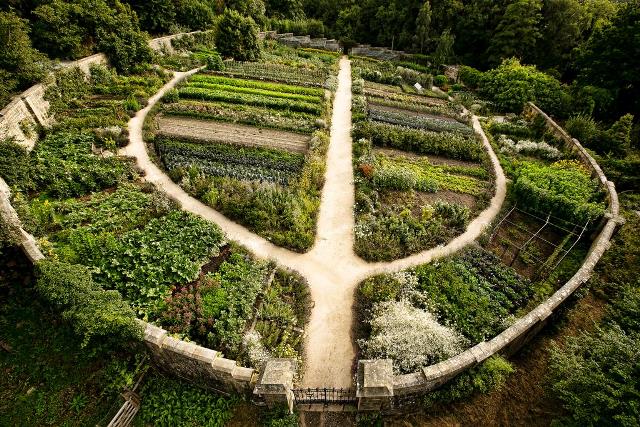Permaculture is a hot idea in many circles from green coalitions to community sponsored agriculture to backyard gardeners. There are permaculture books, permaculture courses, permaculture podcasts and permaculture farms where you can go work and learn as a volunteer. But what is it all about?
At its core permaculture is a clear pathway to attaining an ideal that is slowly gaining power in the collective conscious of the American people: to live in a way that is sustainable, promotes joy and peace and preserves the environment. In other words, to survive as a species. Our current path, with our government subsidized corporate farms, dependence on fossil fuels, unchecked population and consumption growth and disregard for other organisms is one that leads to our own downfall. Permaculture describes a course we can each take as individuals to create an Earth that includes a future for humanity.
For quality farm needs and chicken tractors visit www.thechickentractor.com.au .
What is Permaculture?
The co-founders of permaculture, David Holmgren and Bill Mollison, chose the word as a shortened version of “Permanent Agriculture” and “Permanent Culture”. It is a fitting name for a philosophy based on creating harmonious, sustainable human and natural communities.
Essentially permaculture attempts to create sustainable, or permanent, agriculture systems. These systems should have no waste products and no inputs; instead they are cyclical and self-sustaining just like a natural ecosystem. To achieve these goals, these systems are inherently complex.
While there are guiding permaculture principles and many good examples of permaculture design, true practice of permaculture on any piece of land involves observation and the application of common sense. The idea behind permaculture is to see humans as part of the natural order of things, not separate from it. We are animals, dependent on our environment for food, shelter and water. By carefully designing a garden, forest or pasture that mimics natural ecosystems but is made up of plants and animals that can provide us with our basic needs we can achieve a permanent source of food and materials while creating habitat for other organisms and living in harmony with ourselves and the natural world.
“Permaculture is a philosophy of working with, rather than against nature; of protracted and thoughtful observation rather than protracted and thoughtless labor; of looking at plants and animals in all their functions, rather than treating any area as a single-product system.” Bill Mollison
History
The word “permaculture” is relatively new. It was coined in the 1970’s by David Holmgren and Bill Mollison. The two met in Tasmania when Holmgren was finishing his thesis and Mollison was working as a professor. While the term is new, the principles of permaculture have been practiced for thousands of years, if not longer.
Historical Examples
We see permaculture principles applied in many places around the world throughout history. Here are a few good examples:
- Anthropogenic Amazon Forests – Most of us envision the Amazon as one of the last untouched cradles of biodiversity. While many parts of this vast rain forest are threatened by logging, until recently it was one of the few places on Earth largely uninfluenced by humans. Or was it? Anthropologists now believe that at least 8% and perhaps much more(some scientists suggest nearly 100%) of the Amazon are “anthropogenic”, meaning that they were shaped by indigenous people. The tribes dwelling in the Amazon carefully cut out sections of the forest with stone axes, planting specific food crops and fruit trees. Essentially they created a giant food forest, in a way that so carefully mimicked the natural growth of the jungle that scientists have studied the forest for decades and are only recently noticing the signs of human-influenced patterns.
- Coppiced Forests – Coppicing is a form of forest management common throughout the United Kingdom. Trees are cut either close to the ground or just above the first branches. New growth from the stump or “stool” of the tree is allowed to grow. Most species send up numerous straight “suckers” that grow vigorously thanks to the existing root system and make wonderful straight poles for building or fencing. Livestock can be grazed around the coppiced trees as they regenerate. Coppicing also creates quality habitat for woodland animals.
- Tenganan Village Food Forest – A small village in Bali has protected the forest on the surrounding hills for over 800 years. Today their little patch of forest is considered the last remnant forest in Bali. But that doesn’t mean that humans don’t interact with or benefit from the forest. In fact, the villagers are largely dependent on the forest for food, dyes, oils and medicines. They have been livinto ure its survival and theirs. This is what permaculture is about: understanding that our survival is linked with the survival of the natural world around us, and working to ensure the continuation of both in harmony.
- Natural Farming – More recently Japanese farmer Masanobu Fukuoka, 1913-2008, laid out a careful system for what he called “Natural Farming”. Fukuoka was an inspiration for Mollison’s permaculture. He used mulching, rotational planting of crops and integrated systems of gardening to vastly increase rice and vegetable yields.
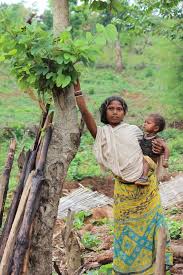
Image courtesy of ipsnews.net
Who Inspired Mollison and Holmgren?
The partnership between Bill Mollison and David Holmgren was serendipitous. Mollison’s practical, hands-on approach coupled with Holmgren’s big picture theoretical way of thinking was the perfect combination to bring centuries of natural and sustainable farming methods together in one clear philosophy: permaculture.
Both permaculture founders used inspiration and ideas from other farmers to develop the principles of permaculture design. Some of those teachers and guides were:
- J. Russel Smith – Author of Tree Crops: A Permanent Agriculture describes how integrating useful species of trees like the Honey Locust, whose pods can be fed to livestock, with pasture land will stabilize the land, enrich the soil and reduce the dependence on environmentally costly grain production.
- P.A. Yeoman – His Keyline Scale of Performance details ways to keep water in the soil, even on sloped farms, by following the natural contour lines of the land.
- Esther Deans – She started the No-Dig gardening movement, using heavy organic mulches to add fertility to the soil from the top down, as happens naturally in forests.
- Christopher Alexander – He is perhaps the most unlikely permaculture inspiration, as he is an architect, not a gardener. Yet Alexander’s Patterns in Architecture helped early permaculturists recognize natural patterns and apply them to an integrated systems design.
This is a very incomplete list. There were many influences on both Holgrem and Mollison from the beginning. The thoughts that led to the idea of permaculture were affected by the farming practices of different cultures, from Native Americans to Australian Aborigines to the Celts.
Mollison and Holmgren published Permaculture One together in 1978, then began to diverge in their work. The split is seen as a positive influence by most of the permaculture community, as it has sparked greater diversity and discussion.
RELATED: Bill Mollison: Father of Permaculture
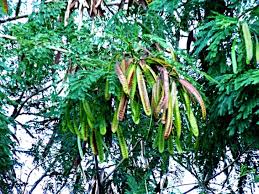
A fast growing, nitrogen fixing tree, the Leacaena is popular in permaculture to improve soil, create mulch and provide animal fodder. Image courtesy of reforestation.me
Practicing Permaculture
Have I piqued your interest in permaculture yet? Let’s delve a bit deeper into the actual theory and practice of permaculture. With a clear understanding of the ethics, principles and techniques of permaculture anyone can begin using it as a tool to improve their land. Permaculture principles can be applied to backyard gardens, urban lots and thousand acre ranches alike.
Ethics
Permaculture is based on three simple values. Every principle and technique builds off of these core ethics:
- Care of the Earth – This is the first priority of permaculture. It is important to do no harm to the Earth in our work, and not to damage its natural systems. This doesn’t mean that we cannot act. Remember, humans are part of the natural systems of Earth, but we should act in concert with all the other elements of those systems.
- Care of the People – The second priority of permaculture is to care for humans, striving to meet each person’s needs to sustain a good quality of life.
- Accepting Limits to Population and Consumption – An important part of permaculture is making the realization that it is impossible to live sustainably on the Earth unless we limit our growth and our consumption. Sometimes this ethic is phrased “Share the surplus, invest all of your means in the first two ethics”, which means we should each limit our personal consumption and work hard on caring for the planet and for other people.
Principles of Permaculture
The principles of permaculture are the practical guidelines for action. If you are planning a new garden, try following these principles. Even if you don’t know any permaculture techniques or strategies, these principles will guide you in creating a more sustainable, ecologically conscious garden.
While there are several different lists from Mollison, Geoff Lawton and others, we’ve chosen David Holgrem’s 12 permaculture principles to share here. They make an excellent start for those new to permaculture. We will look at the twelve principles and consider how you could apply them to creating a new garden space on a small urban lot.
12 Permaculture Principles:
1. Observe and Interact
“Beauty is in the eye of the beholder.”
The first step to good permaculture design requires careful observation. Mollison recommends observing for an entire year before taking action, though other permaculurists suggest that a combination of thoughtful interaction and on-going observation is best.
Applying Principle #1 to our New Backyard Garden:
Take a look around. What is already there? Is it sod? Are there any trees? Maybe one corner has a young pine tree. Instead of removing it, you could use the acidic soil around the tree to cultivate blueberries. Is there a low part of the yard that never dries out properly? Perhaps that is the right spot for a tiny pond at the base of an herb spiral.

Image courtesy of panyaproject.org
2. Catch and Store Energy
“Make hay while the sun shines.”
Recognizing and capitalizing on natural, renewable resources will promote abundance in a permaculture system. We are currently very reliant on fossil fuels, a costly and limited resource. Consider energy from the sun, wind, rain and run-off, as well as waste products from commercial or industrial activities that can be re-purposed.
Storing those resources is also important. Permaculture teaches that the best place to store resources is in the soil. Fertile soil with high humus content is a rich supply of nutrients for food production, plus it will hold water. Perennial vegetation systems, bodies of water and passive solar buildings are other potential sources for energy storage.
Applying Principle #2 to our New Backyard Garden:
Any permaculture garden is constantly striving to improve the organic material present in the soil. Eventually you can grow cover crops like comfrey or use fallen leaves from your fruit trees as mulch, but when you are getting started you may need an outside source. Did your town just cut down branches around the power lines? These usually get run through a woodchipper and discarded. What about those sacks of leaves your neighbors left out for the garbage pick up? You can take these “waste” products and turn them into valuable mulch and fertilizer.
Another example in the home garden would be placing a rain barrel at the corner of the house to collect run-off from the roof via a gutter or rain chain. This water can sustain your permaculture garden during dry-spells without tapping into city water.
3. Obtain a Yield
“You can’t work on an empty stomach.”
Immediate and useful yields are important. It doesn’t help to plan an incredible food forest for your grandkids if your permaculture garden can’t put food on the table today.
The simple truth is that humans seek fast and satisfying rewards. Systems that produce quick, high yields tend to be more successful than ones that don’t. This is in part why deep tilling, fertilizers and pesticides have become so popular. Design your system to provide an immediate benefit in addition to capturing and storing energy to maintain the permaculture system in the long run.
Applying Principle #3 to our New Backyard Garden:
This is the fun part when it comes to gardening. Choose a few fast producing annuals that serve multiple purposes. For instance, a new permaculture garden needs a good supply of nitrogen and leafy green material to help build the soil. While you are planting cover crops and preparing the bed for perennial veggies, plant some sugar snap peas and green beans. These legumes grow quickly, adding valuable nitrogen to the soil, producing lots of green material for mulch and compost and putting delicious fresh peas or beans on your table.
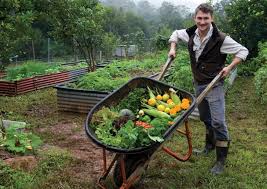
Image courtesy of permacultureprinciples.com
4. Apply Self Regulation and Accept Feedback
“The sins of the fathers are visited on the children of the seventh generation.”
Nature is self-regulatory. It corrects in ways that are often drastic when a system gets out of balance, typically with disease or natural disasters. The goal in permaculture is to recognize the feedback within our systems before an extreme is reached.
The previous permaculture principle is easier to apply. This one is an ideal that permaculture strives towards. It requires constant self-evaluation. Go back to principle #1 – observe. Where are you choosing the easy path instead of the sustainable one? Attempt to make each element in the system as self-reliant as possible.
Applying Principle #4 to our New Backyard Garden:
While it is tempting to choose high yielding, fast producing strains of fruits and vegetables, a wiser choice is a tough, naturally reproducing or wild crop varieties. For example, plant perennial greens like seakale, sorrel and dock instead of kale or chard. Plant wild raspberries, service berries or alpine strawberries instead of the plumper, juicer and more fragile varieties. Even if you have a small yard, plant one or two fruit trees. In a few years they will supply you with an abundance of food and mulch, as well as holding water in your soil and shading your permaculture garden.
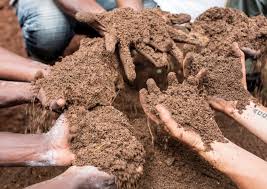
Image courtesy of permacultureprinciples.com
5.Use and Value Renewable Resources and Services
“Let nature take its course.”
Sometimes it is necessary to engage non-renewable resources to establish a permaculture system. However, the end goal should be to remain wholly reliant on renewable resources, ideally generated within the system itself.
Start thinking beyond energy resources into renewable services. For instance, a tree can be used for wood, for building or heating or cooking. But it can also be used for shade, shelter and mulch, all useful benefits that don’t require consuming the tree. Simply changing your perspective to appreciate these non-consumptive resources, which often require no action on your part is a powerful step to designing a sustainable system.
Applying Principle #5 to our Backyard Garden:
Remember when I said “plant a fruit tree”. Well, here’s another reason to do so! That fruit tree is a future goldmine in your yard, even if the whole space is just a 50-100 square feet. It will shade your green vegetables during summer’s heat, provide a trellis for squash, berries, beans or cucumbers to climb, feed your family, chickens or pigs and constantly enrich the soil with its fallen leaves.
6. Produce No Waste
“Waste not, want not” or “A stitch in time saves nine.”
This principle may seem impossible at first glance. But consider what “waste” really means. Anything that can be cycled back through a system is not longer a waste product. While you may not be ready to get a composting toilet and literally recycle all of your waste, you can start with simple steps like mulching or composting.
Applying Principle #6 to our Backyard Garden:
How can you avoid waste when planning your new garden? Start by carefully sourcing any necessary materials. Can you move loose compost to the site in a wheelbarrow instead of purchasing it in bags? Maybe you create a raised bed slowly over time using deep mulch and layering materials like leaves, kitchen scraps, old hay or other organic material on top of existing soil. Perhaps your garden takes 6 months before it is ready for planting but produces no plastic or chemical waste. Plan a small compost site near the garden so your kitchen and lawn scraps can be used to feed your vegetables.
7. Design From Patterns to Details
“Can’t see the forest for the trees.”
Permaculture began with the forest as a model for agriculture. By stepping back and considering this view, you can start to observe patterns on your land, in your community and in society as a whole. Not sure what the patterns are? Go back to permaculture principle one and observe for awhile until they emerge. By focusing on existing patterns and planning patterns you would like to create, you can create a strong design concept and the details will come as they are needed.
Applying Principle #7 to our Backyard Garden:
Permaculture uses “zones of intensity” to help you place elements around your home. For example, zone one is your living space and outdoor areas you frequent multiple times each day. They are close to the house or even within it. You should place things like annual vegetables, which need extra care, and herbs, which you use constantly, in this zone. Fruit trees and perennial permaculture gardens can be placed slightly further from your front door, since you don’t need to visit them as often. By placing each element in the appropriate zone you make caring for your garden easy and natural.
8.Integrate Rather Than Segregate
“Many hands make light work.”
The connections between things are as important if not more important than the things themselves. By placing each element of a system in the right place, the entire whole can work harmoniously. Plants, animals, structures and even people should be placed appropriately to bring the maximum benefit to the system, as well as to attain their own highest level of production. This principle can be summed up by two commonly quoted permaculture statements:
1. Each element performs many functions.
2. Each important function is supported by many elements.
Our Western culture tends to focus on relationships that are competitive or predatory. To create a successful, sustainable permaculture system we need to consider cooperative and symbiotic relationships.
Applying Principle #8 to our Backyard Garden:
Start by considering your garden plan. Research companion planting. By growing marigolds throughout the garden and lining the edges with garlic you can deter pests naturally. Try growing the classic “three sisters” planting of corn, squash and beans. Together they provide a complete source of nutrients, improve the soil and boost each others’ yields.
Try extending this principle to your human interactions. If you live in a city or have a small yard perhaps you can get together with friends and neighbors to create a community permaculture garden in the common spaces of your suburb, block or home owner’s association.
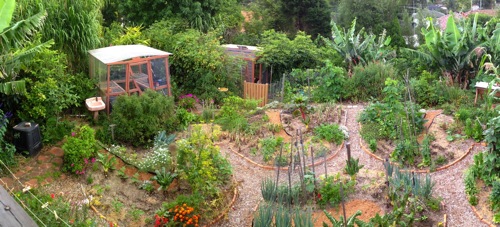
Image courtesy of wikipedia.commons
9.Use Small and Slow Solutions
“Slow and steady wins the race.”
This is the opposite of our cultural values, where bigger and faster is always better. But smaller and slower is healthier, more sustainable and much more energy efficient.
Applying Principle #9 to our Backyard Garden:
A common mistake made by new gardners is to attempt too much at once. Start with a small space, a few species of plants and do it well. A well-managed, consciously planned garden of just 15 square feet can produce more food than 100 square feet of neglected or poorly designed garden space. Focus on slowly improving your soil before worrying about producing lots of veggies, and you’ll be amazed at the output of your permaculture garden by the end of the second season.
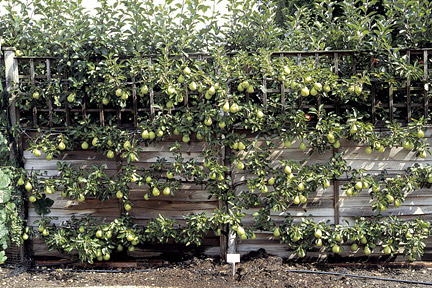
These permaculture pear trees are trained to grow up a trellis to save space in a small garden while giving the soil the benefits of the trees’ root systems and producing lots of pears. Image courtesy of rodalesorganiclife.com
10. Use and Value Diversity
“Don’t put all your eggs in one basket.”
Diversity is insurance against many threats, from disease to bad weather to human mistakes. Our current system of monoculture (raising one species of each crop by itself) has made our food supply vulnerable to disease, drought and climate change. This is true in several ways. A garden with a single crop in it is more likely to fail entirely than one with a variety of vegetables planted. Our large scale agriculture also grows very few strains of an individual crop – just a handful of the hundreds of varieties of corn are grown, just two or three of nearly 1000 types of bananas are grown for commercial use. We are in danger of losing many of the other strains of these common foods, and in danger of suffering a famine if our single crops are decimated in a year of blight or bad weather. Permaculture promotes diversity, providing protection from these dangers.
Applying Principle #10 to our Backyard Garden:
Even in a small, simple permaculture garden you can create a diverse ecosystem. Maybe you’ll plant radishes with carrots in the same row (by the time the carrots start to grow you’ll have already harvested the radishes) next to a row of head lettuce, next to a row of onions, next to a row of radishes and carrots and so on. Around the edges plant cloves of garlic. Dot the permaculture garden with skinny Mexican marigolds and place a calendula, oregano or thyme plant in one corner. You’ve maximized your growing space, give yourself lots of salad veggies and protected your plants from disease. You can help promote diversity more by growing and saving seeds from heirloom vegetables.
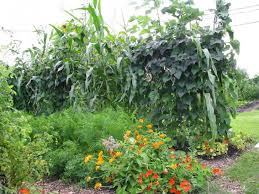
Diverse French Garden. Image courtesy of permafroid.blogspot.com
11.Use Edges and Value the Margins
“Don’t think you are on the right track just because it’s a well-beaten path.”
Permaculture teaches that the edges of any ecosystem are the sites of the greatest diversity. Think of tidal pools and the great abundance of life that thrives at the interface between land and sea. Learn to value edges in any systems. For example, increasing the edges of a pond by making it a wrinkled shape instead of a smooth circle will boost productivity in both the pond and the surrounding land.
Applying Principle #11 to our Backyard Garden:
Edges are useful in a permaculture garden, so design yours to create more of them. Choose a funky shape to increase the edge area. Garden in a star or create jellyfish tendrils of garden into the yard. You can let herbs like thyme hand over the edges of the garden, place trellises for beans or tomatoes along the edge or let a large zucchini plant sprawl over it into the yard. Besides, it is easiest to work on the edges of the garden, so these areas tend to be the most productive.
Don’t forget that the soil is the most important edge for humans. Soil health is of key importance in any permaculture system. Begin improving your soil with cover crops, no-till gardening techniques, compost, mulch and rotational planting.
12. Creatively Use and Respond to Change
“Vision is not seeing things as they are but as they will be.”
Permaculture strives to create durable systems that integrate natural systems and human culture. To be truly sustainable these permaculture systems must have the ability to adapt to changes, both natural and human.
Applying Principle #12 to our Backyard Garden:
When you are first starting a new permaculture garden you will need to enrich the soil. Perhaps you will use nitrogen fixing legumes in the vegetable bed, or plant nitrogen fixing, fast growing bushes around your fruit tree to shelter it and improve the soil. Over time these plants won’t be needed. You will have to eventually remove these nitrogen fixers, using them for fodder, fuel or mulch to allow the food producing tree to thrive. This mimics the natural progression of a forest from pioneer plants to climax. And don’t forget… no forest remains full of climax species forever.
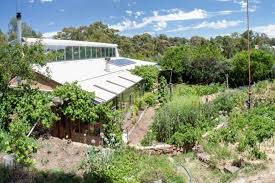
Image courtesy of dmproduce.com.au
Practical Techniques
By following the 12 principles of permaculture and using your common sense you are well on your way to creating a sustainable system to produce food for yourself and your community. However, the permaculture community has developed a variety of tools, techniques and strategies that make achieving the goals of permaculture on any property easier.
Books and pamphlets and year long courses have been written and designed about permaculture techniques. There is simply not time to go into all of them here.
This collection of five simple permaculture tips will go a long way to getting your permaculture garden started.
1. Use Sheet Mulch
Sheet mulching is a permaculture technique used to jumpstart a new garden. It is especially useful if the site for your permaculture garden has bad soil. It can be done by slashing the existing vegetation and covering it with cardboard. Lay down a thin layer of manure, a good foot of straw, a few inches of compost and cover with mulch. Ideally you should let this bed sit for six months before planting into it.
Sheet mulch can be used to start a new permaculture garden bed, or laid around fruit trees to create quality soil for food forest plants.
2. Plant in Guilds
Permaculture guilds are a form of advanced companion planting. A guild starts with a single plant, often a tree. Other plants, including herbs and vegetables are planted around this central plant. The companion plants support the tree or main plant by enriching the soil, deterring pests and attracting pollinators. They may also provide food for the gardener.
For example, an apple tree may be the center of a guild. You could plant a ring of garlic around the tree, along with bulb flowers like tulips. Herbs like tarragon, rosemary and thyme can go in, as well as a bramble bush (blackberry or raspberry) or a nitrogen fixing bush like a pea shrub right next to the apple tree.
Traditionally fruit trees are surrounded by grass, but grass competes directly with the trees’ root system, slowing growth and decreasing productivity. Using a permaculture guild will increase the health and productivity of your trees.
3. Try Hugelkultur
Hugelkultur means “hill culture” and is not unique to permaculture though it has become a very popular gardening technique in the permaculture community. These garden beds are designed to supply a constant flow of nutrients to your garden for years at a time. They require little watering even in dry months, provide excellent drainage and create valuable microclimates for growing different types of plants.
Here’s how you build a permaculture hugelkultur bed:
First you need a lot of wood. Old construction wood that hasn’t been treated works well, or scraps from tree trimming. Avoid pine, as it is very acidic. The larger the pieces the better.
Dig a trench in the ground, about one foot deep and as wide and long as you like. Lay the largest logs in the ditch. Cover with more logs, then with smaller branches. Make the mound as large as you like or have materials for. Keep in mind that it will shrink over time. Cover the branches with twigs and then a thick layer of manure. Top with straw and cover the entire heap with several inches of soil.
You can plant directly into the soil. As the wood decomposes it will slowly release nutrients into the soil. The wood holds moisture, providing a reservoir of water right inside the garden bed. Keep in mind that the first year their won’t be much nitrogen available, so plant legumes. Avoid heavy feeding plants like brassicas until the second or third year.
4. Build a Strawbale Garden
Another non-traditional permaculture garden option is to make a straw-bale bed. There are several ways to go about “soil-less” permaculture gardening with an old bale of straw. Try these two options:
- Plant Directly in the Bale – Place the bale anywhere you like, preferably near the front door if you are going to plant herbs or greens. You can garden with straw bales anywhere. Try it on the rooftop, in your driveway or in that strip of land between the sidewalk and the street.You need to do a little preparation: soak the bale with nitrogen in the form of compost tea, fermented garden or yard waste or organic fertilizer. Water it well for one week. The bale will heat up and start to decompose. After two weeks you are ready to plant seedlings directly into the bale. You can give them a handful or two of compost if they are small. That’s it! They’ll grow happily in the bale as long as you keep watering it. Harvest is easy as the roots pull right out.
- Strawbed Potatoes – Make a box or get a big barrel. Lay your seed potatoes (with the eyes) directly on the ground and cover them with a couple inches of straw. Once the young potato plants pop out of the ground, lay down more straw, leaving about 1/3-1/2 of each plant exposed. Continue covering your potatoes throughout the season. When it is time to harvest just dig through the straw for your spuds.
5. Stack your Garden
Stacking is a very common permaculture practice. You can stack in time or in space.
Stacking in space means planting plants with different heights and different shapes together. For instance, carrots, onions and lettuce can be planted tightly together because they occupy different root spaces. Beans, peas, cucumbers and squash can be trained to grow up trellises, taking up very little space in the garden.
You can also stack in time, by planting things that mature at different times. A common practice is to plant radishes and carrots together. The radishes are ready to harvest before the carrots get big enough to crowd them.
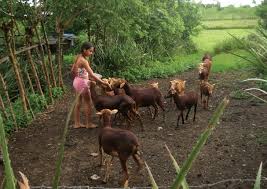
Note the trees used as fence posts. This is a temporary fix, while the slow growing cactus matures into a permanent, sheep-proof fence. Image courtesy of permacultureprinciples.com
Resources
Permaculture is a philosophy that encompasses many ideas. There are a lot of strategies and techniques, some as simple as the gardening tips above, others involving large earthworks, pond building and creating patterns using the contours of the land. If you are interested in pursuing the study of permaculture, check out some of these resources:
- Open Permaculture School – Offers a free online course in permaculture
- Permaculture Research Institute
- Permaculture Institute
Learn more about small-scale permaculture in “Backyard Permaculture: Starting at home…”

